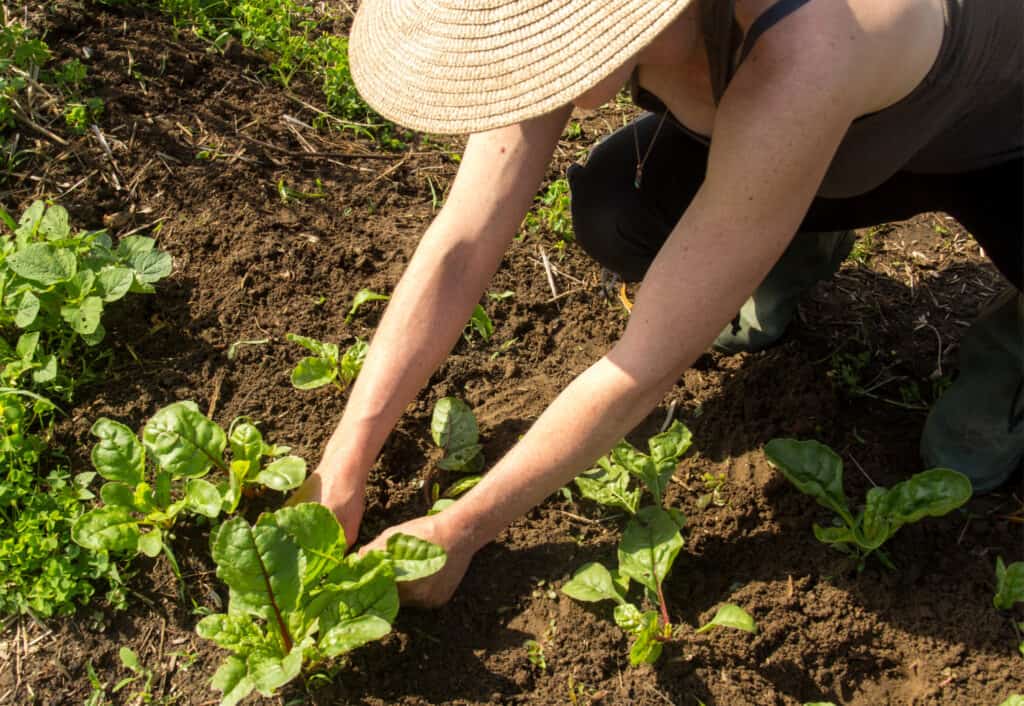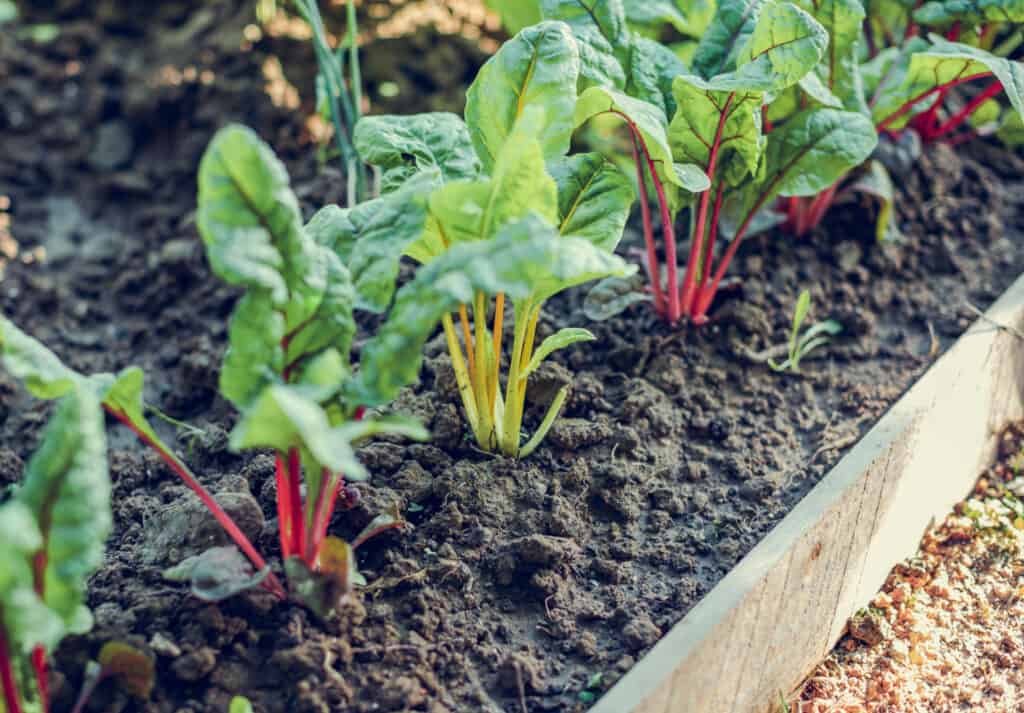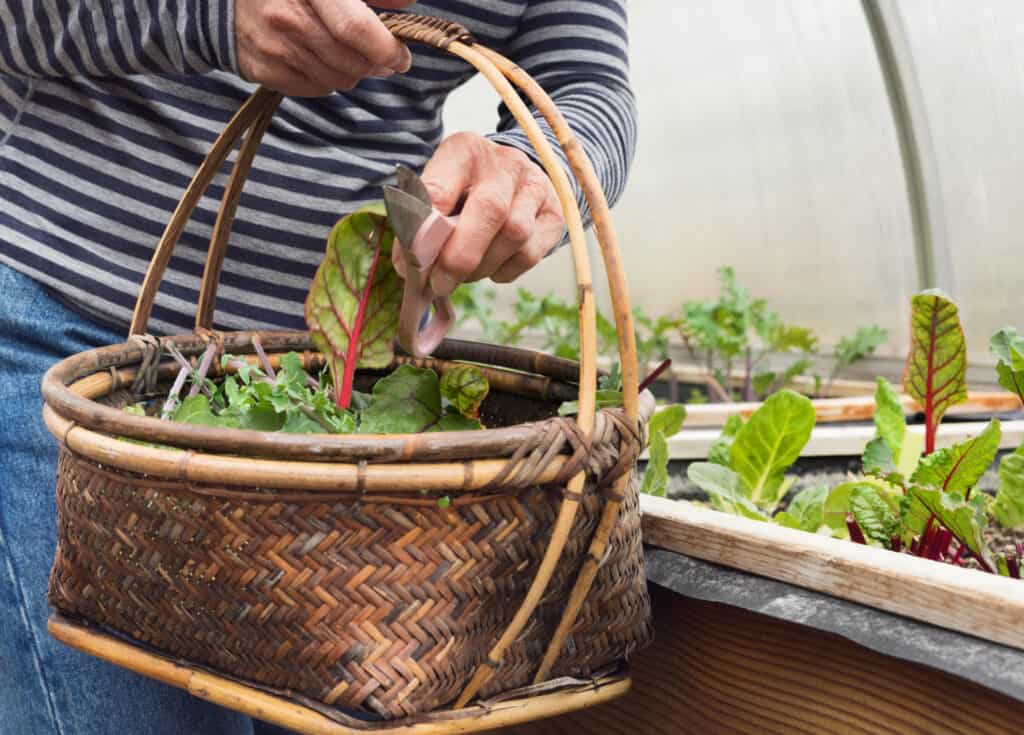How to Grow Swiss Chard for Beginners
Are you ready to add a fun and versatile veggie to your backyard garden, then this guide on How to Grow Swiss Chard for Beginners is next if your line up. Get tips on how to plant, space, fertilize, weed, and harvest this fun salad ingredient.
Another how to grow guide that will be a great addition Gardening 101 library!

Swiss chard may look like a kale or lettuce, but it’s part of the beet family. Instead of a flavorful root though, it has glossy, kale-like leaves with colorful veins, usually bright white, red, magenta, yellow, or orange. The stalks are nice and firm. It’s kind of a combination of spinach and celery with a little neon coloring added in.
Swiss chard is a biennial that grows as an annual and it does well in all planting zones. It prefers cooler temperatures and will still be hardy down to 15° F, but it will also do well in the heat as long as it’s adequately watered.
Full sun to partial shade areas is preferred and the soil should be nutrient-rich and well-draining. The ideal pH level is between 6.0 and 8.0; you may want to do a soil test before planting.
Swiss chard, B. vulgaris, isn’t “day-length sensitive” so it’s less prone to bolting than other leafy greens. In warmer climates, plants set seeds the second year and when they do, they’re no longer tasty. It doesn’t set seeds in colder climates so it’s not a problem.
Fortunately, this plant is known as a “cut and come again” vegetable, meaning that snipping leaves throughout the growing season encourages more leaf formation.
There are several varieties to grow that will add both color to your garden and great taste to your plate.
· Five Color – also known as “Rainbow,” this is not actually a variety on its own, but a combination of seeds with various color stalks and similar growing conditions combined to maximize the colors in your garden.
· Fordhook Giant – known for its great flavor, this variety grows well in most temperatures and produces greenish-white leaves.
· Perpetual – this variety tastes similar to spinach and it regrows very quickly when the outer leaves are harvested.
· Lucullus – a variety best suited for various growing regions, it can tolerate both heat and cold and produces a great flavor.
· Orange Fantasia – this bolt-resistant variety has bright orange stems and dark green leaves. The stalks grow about 8 to 10 inches tall, making it a good choice for container gardens.
· Ruby – this variety looks like a combination of celery and rhubarb with bright red stems and dark green leaves. It’s both ornamental and edible throughout summer and fall.
Seed, Bulb, or Plant?
Swiss chard is grown from irregular shaped seed clusters that each contain several seeds. When buying it, you may find it listed as “pelletized” or “decorticated” meaning that the rough edges have been made smooth. This is necessary for planting it with seeding tools.
You can also start plants indoors and transplant when the soil reaches 50° F. If you do this, remember that seeds are actually seed clusters with several seeds combined. You will need to thin the excess plants before planting.
What You Need to Grow Swiss Chard
Before planting, choose your spot carefully. Swiss chard will need plenty of sunlight, nutrient-rich and well-draining soil, and lots of room. It will grow anywhere from 8 to 24 inches tall depending on the variety you plant.
When to Plant Swiss Chard
Swiss chard should be planted in the spring, 2 to 4 weeks before the last frost of the season. Since their roots aren’t very deep, Swiss chard does well in the ground as well as raised garden beds and containers making it a perfect addition to even small gardens.

Temperature
Swiss chard can grow in most temperatures, highs and lows, through spring, summer, and fall as long as they are watered adequately. Plan to start planting 2 to 4 weeks before the last frost and you will be able to continue harvesting through the fall. Seeds will germinate best though when the soil is at least 50° F. If temperatures reach above 80° F, be sure to water a little more regularly and cover the ground with mulch to keep the soil cool.
Sun
While Swiss chard will tolerate partial sun, it grows best in full sun, at least 6 to 8 hours per day.
Soil
Nutrient-rich and well-draining soil is best with a pH of 6.0 to 8.0, although 6.0 to 6.8 is preferred. Mix in several inches of aged compost or organic matter before planting seeds.
Water
All leafy greens, including Swiss chard, need 1 to 1 ½ inches of water each week. This can be a combination of rain water and supplemental watering.
Fertilizing
Feeding your Swiss chard throughout the growing process with a continuous-release plant food will help produce a healthy harvest.
Support
Swiss chard grows close to the ground, no more than about 20 inches high, so it doesn’t require a support system during growth.
How Much to Plant
Since you can harvest only the outer leaves and allow the plant to regrow, you’ll only need 2 to 3 plants per person. To make sure you can harvest regularly, you’ll want to space out your plantings by a few weeks and plant a few times over the spring and early summer.
How Long Does Swiss Chard Take to Grow?
Most varieties will be ready to harvest within 50 to 60 days.

How to Plant Swiss Chard
Get ready to start planting 2 to 4 weeks before the last frost. You can start early indoors if you’d like then transplant outside when the ground is ready. You can also plant in raised beds or containers that are deep enough to plant seeds about 12 inches deep.
If you live in a warmer region, you may be able to direct sow up to 10 weeks before the last frost, depending on your soil temperature. Seedlings can be transplanted at about 4 weeks.
Sow your seeds in nutrient-rich soil that has been supplemented with compost, fertilizer, or other organic matter. A soil test will help you determine what you need to add. Leafy vegetables like Swiss chard benefit the most from nitrogen supplementation. A slow-release fertilizer can help with this.
Before planting, harden off your seedlings by acclimating them to the outdoors. Place them outside for a couple of hours a day for several days before transplanting.
Make sure your soil has good drainage, to much moisture in the soil can cause mold and other diseases.
Place one seedling or one seed cluster every 12 inches with rows spaced about 18 inches apart. If planting seeds, you’ll need to thin as they start to germinate. If planting seedlings, thin them before transplanting.
Give the soil a good watering and never let it completely dry out between waterings.
Outer leaves can be harvested starting when they’re about 6 inches tall. These baby greens are more tender and tastier. If you plan to harvest them when they’re smaller, you can plant seeds or seedlings a little closer together.

Spacing
Seeds should be spaced 12 inches apart with rows about 18 inches apart. Remember that seeds are actually seed clusters so you’ll be planting a few seeds with each cluster and may need to thin the plants after they germinate.
Depth
Prepare your soil up to 12 inches deep, mixing in fertilizer or organic matter before planting.
Growing Tips for Swiss Chard
· Swiss chard does not have to be harvested all at once. You can harvest just the outer leaves when they are large enough to eat, they’ll be more tender and flavorful when they’re young. This will also encourage regrowth of outer leaves, giving you more to enjoy.
· To enjoy more all season long, you can space your planting out and plant several times throughout the spring and summer so that it’s ready to harvest at different times.
· Good companion vegetables include broccoli, Brussels sprouts, radishes, and cabbage. Lettuce, mint, sweet alyssum and chamomile also do well. These all require the same type of soil, temperatures, sun, and water. Sweet alyssum and chamomile will also encourage pollinators.
· Adding birdbaths and birdhouses to your garden area will encourage more birds that will feed on insects and other pests.
· Avoid planting corn, cucumber, melon, potatoes, and pumpkin near Swiss chard.
· If you grow as an annual, your plants won’t go to seed. But, if you over winter your plants, they’ll rebloom in the spring with tiny green flowers that set seed at the end of the second growing season. Once you start to see this, the leaves will start to taste bitter and you’ll need to watch for seed pod formation. When the pods look brown, remove the entire stalk and lay them in an open paper bag in a dry location. After drying out for a week or two, rub your fingers down each stalk to release the dry seed clusters. Separate them from the stalk and store them in jars or plastic storage bags in a cool, dry place. You can replant these seeds for up to 5 years.
How to Harvest Swiss Chard
To enjoy more often, start harvesting the outer leaves when they are about 6 inches tall. They’ll be tender and tasty and this will allow for more regrowth. When harvesting, make a clean cut across the stem about an inch above the base of the plant.
As temperatures start to drop and light frosts begin, dig up the plants, roots and all. If you leave some of the soil attached, you can store them in a cool, moist place for continued growth and more harvesting into winter.
If you don’t plan to continue harvesting into winter, you can either cut off individual stems or the entire plant at soil level for the final harvest.
How to Store Swiss Chard
Rinse off the leaves and stems before storing and pat dry. Harvested leaves will stay fresh for up to 3 days in the refrigerator. You can also place them in a plastic storage bag with a damp paper towel and they’ll last up to a week in the fridge.
You can also blanch and cool the leaves and freeze them up to a year. You can also freeze raw, dry leaves. The stalks can be pickled.
Diseases and Pests to Watch Out For
Like other fruits and vegetables in your garden, Swiss chard are susceptible to some pests and diseases. A few to watch out for include:
· Herbivores such as deer and rabbits. You can deter them by using row covers or adding chicken-wire around your plants.
· Poor soil, drainage, spacing or weed control can welcome a number of insects including aphids, beet leafhopper, flea beetle, slugs, and leaf miners. They’ll carry disease and eat your plants. They will also lay eggs, creating a bigger problem. Practice crop rotation to keep them out of your soil and use floating row covers to deter them. If you find them, you can hand pick them off or knock them off with a stream of water from the hose.
· Swiss chard isn’t prone to disease, but over or under watering can make them susceptible and cause growth deformity causing curly top disease, fungal conditions, and root rot. An organic fungicide can help. Try not to oversaturate the plants, they won’t recover from that. It is best to water lightly, but more frequently instead of watering a lot at one time.
Swiss chard is a fairly easy vegetable to grow and when you harvest only the outer leaves, it will regrow again and again all season, giving you plenty to enjoy without planting a lot of seed. It also works well as a companion plant to many other vegetables in your garden, making it a good addition. And, since you can freeze it, you can enjoy it all year long, even months after your last harvest.
You’ll definitely want to make room for a few heads of Swiss chard in your garden.
